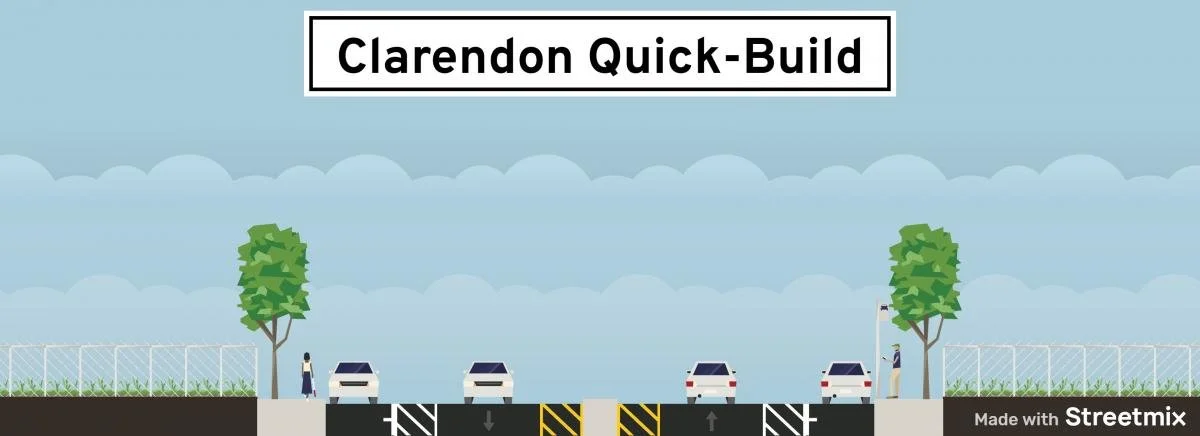What’s happening
Clarendon Ave is the first street on the city’s bike plan to get repaved.
A quick build safety project is planned to slow vehicles speeds on the street, but it does not include a protected bike facility—which should be included based on national standards and the city’s Biking and Rolling Plan
Send an email to the project team asking for Clarendon to get a protected bike lane! Even if the bike lane doesn’t get included now, SFMTA needs to hear that we can’t ignore the city’s commitments in the Biking and Rolling Plan.
Read on for more info 👇
In the spring of this year, San Francisco finally updated its bike plan for the first time since 2009. The new Biking and Rolling Plan promised something big: a “North Star network” of bike routes that would feel safe for everyone–kids on their own bikes going to school, seniors on e-bikes getting to the store, daily commuters, delivery workers on scooters, and everyone in between. The idea was simple but powerful: construct a connected network within 5 years that’s safe and comfortable and accessible within a 5 minute walk of every San Franciscan.
The city also laid out a policy roadmap to get there. One of its principles was that biking and rolling network upgrades should be aligned with street repaving projects, to make the most of limited budgets and minimize disruption for residents and businesses.
Now, the plan is getting put to the test on Clarendon Avenue.
Clarendon is a wide, fast road that connects the east and west sides of the city, and it runs right past a school. It’s also on San Francisco’s High-Injury Network, the small percentage of streets where most of the city’s serious crashes happen. The speed limit is 35mph, a speed at which crashes are often deadly.
This year, Clarendon is getting repaved. SFMTA is taking advantage of the repaving to complete a “quick build” safety project, which will remove a travel lane to slow down traffic. That’s a good start. But here’s the problem: Despite being marked as a bike route in the city’s own plan—and community feedback during the outreach process asking for bicycle safety improvements—Clarendon’s redesign does not include a protected bike lane. Indeed, it does not include a bike lane at all.
Cross-section of Clarendon quick-build from SFMTA project files.
That means anyone who bikes, whether it’s a parent picking up kids from school or a commuter trying to cross the city, is still left to ride unprotected next to fast car traffic. It’s not just uncomfortable, it’s dangerous.
It doesn’t have to be this way. When a car lane is removed, it creates new space. That space could easily become a protected bike lane, separated from speeding cars. National design standards are clear: on streets where cars travel faster than 25 mph, only protected bike lanes count as safe for “all ages and abilities.” By that measure Clarendon should have one.
What’s more, since the city has already identified Clarendon as a high-injury corridor, SFMTA should be applying the best available design treatments to reduce the risk of future crashes.
Clarendon is one of the first streets identified in the Biking and Rolling Plan to undergo a repaving project and quick build at the same time. Yet if the city won’t build a bike lane here, when the street is being repaved, the community wants it, the district supervisor is supportive, and the plan explicitly calls for it, where will they build one?
If there are technical design concerns, they can typically be solved. The school community expressed concerns in the community process about managing pick up and drop off queues. Other schools along bike routes, like Friends School on Valencia, have solved this with boarding islands that provide clear separation between bikes, cars, and kids crossing to school.
The Fire Department has expressed concerns about having enough space between parked cars and a concrete median to access homes in case of an emergency. Yet many other bike facilities in San Francisco have been designed to be wide enough for an emergency vehicle to use. San Francisco knows how to solve tricky design problems on our streets to make them safer.
What’s missing is the political will to follow through.
If you care about safe streets and want to see the city live up to its promises, now is the moment. Send an email to SFMTA to ask them to add a protected bike lane to the Clarendon project. The city’s new bike plan is only as strong as its first test.


